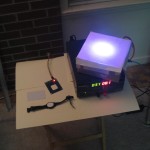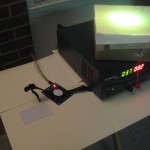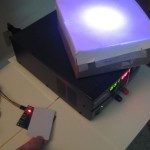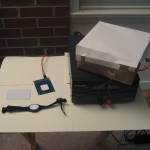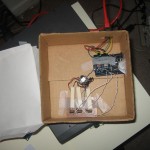RFID-enabled RGB LED lamp
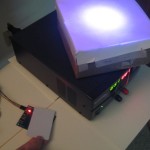 I’m proud to say that this project is now complete. After much hard work in the eleventh hour the project came together quite well and worked perfectly during my demonstration earlier today. Huge thanks to Dr. Ken Trantham, chair of the Physics department, for lending me his expertise and time helping me with this project and teaching me some new things along the way.
I’m proud to say that this project is now complete. After much hard work in the eleventh hour the project came together quite well and worked perfectly during my demonstration earlier today. Huge thanks to Dr. Ken Trantham, chair of the Physics department, for lending me his expertise and time helping me with this project and teaching me some new things along the way.
If you’re jumping right into this post without having read the previous two parts I have posted here’s a quick run-down of this project: using an Arduino I was planning to interface an RFID reader with an RGB LED in order to demonstrate the proof-of-concept that its entirely possible to create interfaces which in effect seem completely transparent to the user. As the following pictures will show I created a simple box housing all the necessary electronics and connected an RFID module to the box using CAT6 cabling to allow for a bit of modularity.
For this project I will not post the schematic I ended up using simply because one was not actually drawn up. The professor I worked with had done this sort of circuit enough times to know how to approach it so we went straight to breadboard to protoboard. I can say that essentially we used an inverted TTL PWM signal from the Arduino to control a MOSFET which connected the RGB LEDs to a separate high current power supply necessary to drive the LEDs.
Originally I planned to implement a sort of ‘programming mode’ to the lamp in which a user could connect a module of three slide pots which can be used to control the color of the LED channels once an RFID tag has been passed. In a more plain sense I mean to say that if a user wishes to modify the color associated with their tag or to create a new association between a tag and a color they could pass that tag and adjust the slide pots until they found a pleasing color and hit a button to ‘set’ the association; passing that tag at any point later would change the RGB color to the new value for that tag. But due to time constraints this functionality was not implemented.
Overall I am very satisfied with this project as a proof of concept that can be elaborated upon in the future, which it likely will be. We have acquired a wireless RFID module which can be used to create a, well, wireless connection to an Arduino / PC for the purposes of home automation. When you come home tired and in need of relaxation just pass your tag over the reader and have your environment adapt to your personal preferences: light levels dimmed, TV turned on, have your computer log you in and check for new e-mail / news, etc. Not outside the realm of possibility by a long shot, I just hope a student will take the initiative to execute the idea in the future as a research project.

